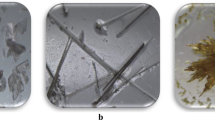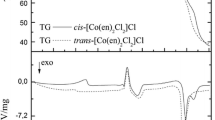Abstract
The collision-induced dissociation (CID) of cationic fatty acid–metal ion complexes has been extensively studied and, in general, provides rich structural information. In particular, charge-remote fragmentation processes are commonly observed allowing the assignment of double bond position. In a previous manuscript, we presented two methods to doubly deprotonate polyunsaturated fatty acids to form anionic fatty acid–sodium ion complexes, referred to as [M – 2H + Na] – ions. In the current manuscript, the CID behavior of these [M – 2H + Na] – ions is investigated for the first time. Significantly, we also present a deuterium-labeling experiment, which excludes the possibility that deprotonation occurs predominately at the α-carbon in the formation of fatty acid [M – H + NaF]– ions. This supports our original proposal where deprotonation occurs at the bis-allylic positions of polyunsaturated fatty acids. CID spectra of polyunsaturated fatty acid [M – 2H + Na]– ions display abundant product ions arising from acyl chain cleavages. Through the examination of fatty acid isomers, it is demonstrated that double bond position may be unequivocally determined for methylene-interrupted polyunsaturated fatty acids with three or more carbon–carbon double bonds. In addition, CID of [M – 2H + Na]– ions was applied to 18:3 isomers of Nannochloropsis oculata and three isomers were tentatively identified: ∆9,12,1518:3, ∆6,9,1218:3, and ∆5,8,1118:3. We propose that structurally-informative product ions are formed via charge-driven fragmentation processes at the site of the resonance-stabilized carbanion as opposed to charge-remote fragmentation processes, which could be inferred if deprotonation occurred predominately at the α-carbon.

ᅟ








Similar content being viewed by others
References
Wallis, J.G., Watts, J.L., Browse, J.: Polyunsaturated fatty acid synthesis: what will they think of next? Trends Biochem. Sci. 27(9), 467–473 (2002)
Tomer, K.B., Crow, F.W., Gross, M.L.: Location of double-bond position in unsaturated fatty acids by negative ion MS/MS. J. Am. Chem. Soc. 105(16), 5487–5488 (1983)
Crockett, J.S., Gross, M.L., Christie, W.W., Holman, R.T.: Collisional activation of a series of homoconjugated octadecadienoic acids with fast atom bombardment and tandem mass spectrometry. J. Am. Soc. Mass Spectrom. 1(2), 183–191 (1990)
Jensen, N.J., Tomer, K.B., Gross, M.L.: Collisional activation decomposition mass spectra for locating double bonds in polyunsaturated fatty acids. Anal. Chem. 57(11), 2018–2021 (1985)
Kerwin, J.L., Wiens, A.M., Ericsson, L.H.: Identification of fatty acids by electrospray mass spectrometry and tandem mass spectrometry. J. Mass Spectrom. 31(2), 184–192 (1996)
Thomas, M.C., Dunn, S.R., Altvater, J., Dove, S.G., Nette, G.W.: Rapid identification of long-chain polyunsaturated fatty acids in a marine extract by HPLC-MS using data-dependent acquisition. Anal. Chem. 84(14), 5976–5983 (2012)
Yang, K., Zhao, Z.D., Gross, R.W., Han, X.L.: Identification and quantitation of unsaturated fatty acid isomers by electrospray ionization tandem mass spectrometry: A shotgun lipidomics approach. Anal. Chem. 83(11), 4243–4250 (2011)
Adams, J., Gross, M.L.: Tandem mass spectrometry for collisional activation of alkali metal-cationized fatty acids: a method for determining double bond location. Anal. Chem. 59(11), 1576–1582 (1987)
Davoli, E., Gross, M.L.: Charge remote fragmentation of fatty acids cationized with alkaline earth metal ions. J. Am. Soc. Mass Spectrom. 1(4), 320–324 (1990)
Hsu, F.F., Turk, J.: Distinction among isomeric unsaturated fatty acids as lithiated adducts by electrospray ionization mass spectrometry using low energy collisionally activated dissociation on a triple stage quadrupole instrument. J. Am. Soc. Mass Spectrom. 10(7), 600–612 (1999)
Hsu, F.F., Turk, J.: Elucidation of the double-bond position of long-chain unsaturated fatty acids by multiple-stage linear ion-trap mass spectrometry with electrospray ionization. J. Am. Soc. Mass Spectrom. 19(11), 1673–1680 (2008)
Afonso, C., Riu, A., Xu, Y., Fournier, F., Tabet, J.C.: Structural characterization of fatty acids cationized with copper by electrospray ionization mass spectrometry under low-energy collision-induced dissociation. J. Mass Spectrom. 40(3), 342–349 (2005)
Blagojevic, V., Samad, S.N., Banu, L., Thomas, M.C., Blanksby, S.J., Bohme, D.K.: Mass spectrometric study of the dissociation of Group XI metal complexes with fatty acids and glycerolipids: Ag2H+ and Cu2H+ ion formation in the presence of a double bond. Int. J. Mass Spectrom. 299(2/3), 125–130 (2011)
Jackson, A.U., Shum, T., Sokol, E., Dill, A., Cooks, R.G.: Enhanced detection of olefins using ambient ionization mass spectrometry: Ag(+) adducts of biologically relevant alkenes. Anal. Bioanal. Chem. 399(1), 367–376 (2011)
Thomas, M.C., Kirk, B.B., Altvater, J., Blanksby, S.J., Nette, G.W.: Formation and fragmentation of unsaturated fatty acid [M – 2H + Na]– ions: stabilized carbanions for charge-directed fragmentation. J. Am. Soc. Mass Spectrom. 25(2), 237–247 (2014)
Budimir, N., Blais, J.C., Fournier, F., Tabet, J.C.: Desorption/ionization on porous silicon mass spectrometry (DIOS) of model cationized fatty acids. J. Mass Spectrom. 42(1), 42–48 (2007)
Trimpin, S., Clemmer, D.E., McEwen, C.N.: Charge-remote fragmentation of lithiated fatty acids on a TOF-TOF instrument using matrix-ionization. J. Am. Soc. Mass Spectrom. 18(11), 1967–1972 (2007)
Cheng, C.F., Gross, M.L.: Applications and mechanisms of charge-remote fragmentation. Mass Spectrom. Rev. 19(6), 398–420 (2000)
Gross, M.L.: Charge-remote fragmentation: an account of research on mechanisms and applications. Int. J. Mass Spectrom. 200(1/3), 611–624 (2000)
Adams, J.: Charge-remote fragmentations: analytical applications and fundamental studies. Mass Spectrom. Rev. 9(2), 141–186 (1990)
Yang, K., Dilthey, B.G., Gross, R.W.: Identification and quantitation of fatty acid double bond positional isomers: a shotgun lipidomics approach using charge-switch derivatization. Anal. Chem. 85(20), 9742–9750 (2013)
Thomas, M.C., Mitchell, T.W., Blanksby, S.J.: Ozonolysis of phospholipid double bonds during electrospray ionization: a new tool for structure determination. J. Am. Chem. Soc. 128(1), 58–59 (2006)
Thomas, M.C., Mitchell, T.W., Harman, D.G., Deeley, J.M., Murphy, R.C., Blanksby, S.J.: Elucidation of double bond position in unsaturated lipids by ozone electrospray ionization mass spectrometry. Anal. Chem. 79(13), 5013–5022 (2007)
Thomas, M.C., Mitchell, T.W., Harman, D.G., Deeley, J.M., Nealon, J.R., Blanksby, S.J.: Ozone-induced dissociation: elucidation of double bond position within mass-selected lipid ions. Anal. Chem. 80(1), 303–311 (2008)
Harvey, D.J.: A new charge-associated mechanism to account for the production of fragment ions in the high-energy CID spectra of fatty acids. J. Am. Soc. Mass Spectrom. 16(2), 280–290 (2005)
Acknowledgments
The authors acknowledge Moreton Bay Research Station (MBRS) for providing laboratory space. M.C.T. acknowledges Dr. Mei Bai (University of Melbourne) for support while preparing this manuscript. M.C.T also acknowledges Professor Stephen Blanksby (University of Wollongong) and Dr. Ben Kirk (Lawrence Berkeley National Laboratory) for their keen insights into this topic.
Author information
Authors and Affiliations
Corresponding author
Electronic supplementary material
Below is the link to the electronic supplementary material.
ESM 1
(DOCX 270 kb)
Rights and permissions
About this article
Cite this article
Thomas, M.C., Altvater, J., Gallagher, T.J. et al. Collision-Induced Dissociation of Fatty Acid [M – 2H + Na]– Ions: Charge-Directed Fragmentation and Assignment of Double Bond Position. J. Am. Soc. Mass Spectrom. 25, 1917–1926 (2014). https://doi.org/10.1007/s13361-014-0966-0
Received:
Revised:
Accepted:
Published:
Issue Date:
DOI: https://doi.org/10.1007/s13361-014-0966-0




